
In this article, I will describe the top 10 most beautiful historical sites for tourists in Romania, including the medieval wonders of Bran Castle, the ancient ruins of Sremzigetosa Regia, and the picturesque streets of Sibiu.
Here are the top 10 historical sites in Romania for tourists:
1. Bran Castle
2. Peleș Castle
3. Corvin Castle
4. Sighisoara Historic Center
5. Voroneț Monastery
6. Sucevița Monastery
7. Piața Unirii (Union Square) in Timișoara
8. The Merry Cemetery
9. Râșnov Fortress
10. Alba Iulia Citadel
1. Bran Castle Romania.
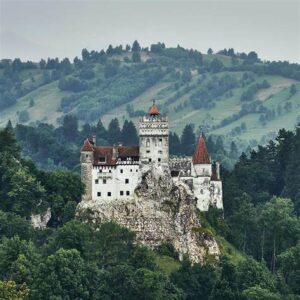
Bran Castle, perched on a dramatic cliff in the heart of Transylvania, Romania, is one of the country’s most popular and intriguing tourist destinations.
Often referred to as “Dracula’s Castle,” this medieval fortress is shrouded in legend and history, making it a must-visit for those exploring Romania.
Constructed in the 14th century, Bran Castle’s stone walls, narrow passageways, and towers create a mysterious and grand aura.
Despite its association with Bram Stoker’s fictional character, Count Dracula, there is no evidence that Vlad the Impaler, the inspiration for Dracula, ever lived here.
Nonetheless, the castle’s gothic appearance and eerie ambiance have cemented its place in popular culture.
The castle’s interior is equally captivating, with a labyrinth of rooms and corridors filled with antique furniture, medieval weaponry, and art collections.
Highlights include the Queen Marie’s bedroom, the Music Hall, and the secret passage that links the first and third floors.
Each room is carefully preserved, offering a glimpse into the royal lives of Romania’s past.
Surrounding Bran Castle is a charming village with traditional Romanian houses, souvenir shops, and local restaurants.
The nearby Bran Village Museum showcases rural life with exhibits of traditional clothing, tools, and crafts.
Visiting Bran Castle during Halloween offers an extra layer of excitement, as the castle hosts themed events and parties that draw tourists worldwide.
The stunning Carpathian Mountains enhance Bran Castle’s enchantment, blending history, legend, and natural beauty into a must-visit destination.
Whether you’re a history buff, a fan of gothic fiction, or simply looking for a unique travel experience, Bran Castle is one of the most important historical sites for tourists to explore the cultural and historical landscape at the heart of Romania. Offers an unforgettable journey.
2. Peleș Castle Romania
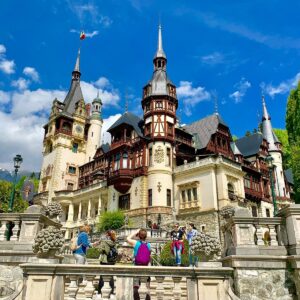
Peleș Castle, nestled in the Carpathian Mountains near Sinaia, Romania, is a stunning architectural masterpiece and a must-visit destination for tourists.
Built between 1873 and 1914, this neo-Renaissance castle served as the summer residence of Romania’s royal family and stands as a testament to the country’s rich cultural heritage.
The castle’s exterior blends Gothic Revival, Renaissance, and Baroque styles, adorned with intricate woodwork, statues, and decorations.
Its fairytale appearance, set against the backdrop of lush forests and towering mountains, creates a picturesque scene that captivates visitors at first sight.
Inside Peleș Castle, the opulence continues with over 160 rooms, each exquisitely decorated and filled with priceless art, antique furniture, and luxurious textiles.
Highlights include the Grand Hall with its wooden staircase and stained-glass ceiling, and the Royal Library with rare books and a hidden door..
The Music Room, decorated in Indian style, and the Moorish Salon, with its oriental design, showcase the diverse artistic influences that characterize the castle.
The castle boasts modern amenities like central heating, electricity, and a retractable glass roof, showcasing its advanced design.
The surrounding gardens and terraces of Peleș Castle are equally enchanting, offering panoramic views of the Bucegi Mountains.
The gardens are meticulously landscaped, with statues, fountains, and pathways that invite leisurely strolls and relaxation.
Visitors to Peleș Castle can also explore the nearby Pelisor Castle, a smaller but equally charming residence built for King Ferdinand and Queen Marie.
The charming town of Sinaia, with its historic monasteries, hotels, and ski resorts, offers additional attractions for tourists.
A visit to Peleș Castle is a journey into Romania’s royal past, providing a unique blend of history, art, and natural beauty that leaves a lasting impression on all who visit.
3. Corvin Castle Romania
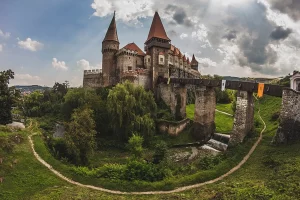
Corvin Castle, also known as Hunyadi Castle or Hunedoara Castle, is a stunning medieval fortress located in Hunedoara, Romania.
This architectural masterpiece is one of the largest castles in Europe and a must-visit destination for tourists seeking to immerse themselves in history and marvel at breathtaking Gothic architecture.
Constructed in the 15th century on the site of a former Roman camp, Corvin Castle served as a strategic stronghold for the Hunyadi family, one of the most influential noble families in Transylvania.
The castle’s imposing towers, drawbridge, and well-preserved fortifications offer visitors a glimpse into the past, transporting them to a time of knights, battles, and royal intrigue.
Tourists greet themselves with a magnificent courtyard surrounded by impressive stone walls and towers upon entering the castle grounds.
The interior of Corvin Castle is equally captivating, with ornate chambers, grand halls, and intricate frescoes that showcase the wealth and power of its former inhabitants.
Visitors can explore the castle’s various rooms, including the Knight’s Hall, where banquets and ceremonies were held, the Chapel, adorned with stunning stained glass windows, and the Torture Chamber, which offers a chilling glimpse into the darker aspects of medieval life.
In addition to its historical significance, Corvin Castle also offers stunning views of the surrounding countryside, making it a picturesque setting for photography enthusiasts.
Whether you are a history buff, architecture enthusiast, or simply looking to experience the magic of a medieval fortress, a visit to Corvin Castle is sure to leave a lasting impression on all who venture within its walls.
4. Sighisoara Historic Center Romania
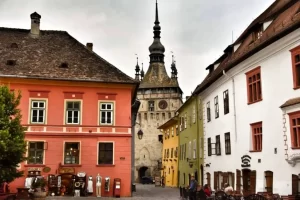
Sighișoara one of the most beautiful Historical sites, a UNESCO World Heritage Site, is a charming medieval town located in Transylvania, Romania, and is a must-visit destination for tourists seeking to immerse themselves in history and culture.
People (or visitors) renowned this well-preserved citadel for its picturesque cobblestone streets, colorful buildings, and impressive fortifications that date back to the 12th century.
The heart of Sighișoara is the Citadel Square, a bustling hub lined with historic buildings, artisan shops, and quaint cafes.
Visitors can wander through the narrow alleyways, admiring the well-preserved architecture and soaking in the ambiance of a bygone era.
The Clock Tower, a symbol of the town, offers panoramic views of the surrounding area and houses a museum showcasing the town’s history.
One of the highlights of a visit to Sighișoara is exploring the birthplace of Vlad the Impaler, also known as Dracula.
The house where Vlad was born is now a restaurant and museum, offering visitors a glimpse into the life of this infamous historical figure.
In addition to its historical significance, Sighișoara hosts various cultural events and festivals throughout the year, including medieval reenactments, concerts, and craft fairs.
The town’s vibrant atmosphere and welcoming locals make it a delightful place to explore and experience Romanian hospitality at its finest.
Whether you are a history enthusiast, architecture lover, or simply looking to immerse yourself in the charm of a medieval town, Sighișoara Historic Center promises a memorable and enchanting experience for all who visit.
5. Voroneț Monastery Romania
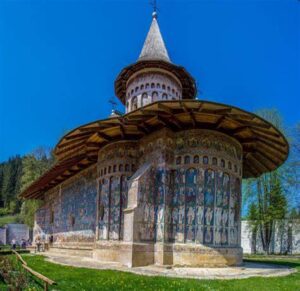
Tourists can explore Voroneț Monastery, located in the picturesque region of Bukovina in northeastern Romania, is one of the UNESCO World Heritage and most beautiful historical sites renowned for its stunning frescoes and rich history.
Founded in the late 15th century by Stephen the Great, one of Romania’s most revered rulers, Voroneț Monastery is often referred to as the “Sistine Chapel of the East” due to its vibrant blue exterior and intricate frescoes that adorn its walls.
The monastery’s exterior walls are painted in a striking shade of blue known as “Voroneț blue,” a color that has become synonymous with the monastery and is said to have been created using a secret formula involving lapis lazuli.
The frescoes depict scenes from the Bible, as well as images of saints, angels, and demons, all rendered in exquisite detail and vibrant colors that have stood the test of time.
Visitors to Voroneț Monastery can explore the interior of the church, which features a beautifully decorated altar, iconostasis, and a collection of religious artifacts dating back centuries.
Certainly, the peaceful atmosphere of the monastery grounds, surrounded by lush greenery and rolling hills, offers a serene retreat for those seeking spiritual reflection and cultural enrichment.
In addition to its religious significance, Voroneț Monastery is a testament to the artistic and architectural achievements of medieval Romania, making it a must-visit destination for tourists interested in history, art, and culture.
A visit to Voroneț Monastery is sure to leave a lasting impression on all who appreciate the beauty and heritage of this remarkable site.
6. Sucevița Monastery Romania
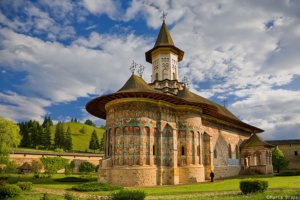
Sucevița Monastery, located in the picturesque region of Bukovina in northeastern Romania, is a gem of Orthodox religious architecture and a UNESCO World Heritage Site.
Basically, this stunning monastery, built in the 16th century, is renowned for its vibrant frescoes, intricate architectural details, and serene natural surroundings, making it a must-visit destination for tourists seeking spiritual enrichment and cultural immersion.
Additionally, the exterior walls of Sucevița Monastery are adorned with beautifully preserved frescoes depicting scenes from the Bible, the lives of saints, and intricate geometric patterns in vibrant hues of blue, red, and green.
These frescoes considered masterpieces of Byzantine art, offer visitors a glimpse into the religious and cultural heritage of the region, showcasing the skill and creativity of the medieval craftsmen who adorned the monastery walls.
Inside the monastery complex, tourists can explore the various buildings, including the church, bell tower, and living quarters, all of which feature traditional Moldavian architectural elements such as carved wooden doors, painted ceilings, and ornate iconostases.
The peaceful atmosphere of Sucevița Monastery, surrounded by lush forests and rolling hills, provides a tranquil setting for contemplation and reflection.
Indeed, visitors to Sucevița Monastery can attend religious services, participate in guided tours, and purchase handmade religious artifacts and souvenirs from local artisans.
Whether you are a history enthusiast, art lover, or spiritual seeker, a visit to Sucevița Monastery offers a unique opportunity to experience the rich cultural heritage and spiritual traditions of Romania in a truly enchanting setting.
7. Piața Unirii (Union Square) in Timișoara Romania
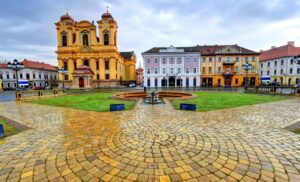
Piața Unirii, or Union Square, is one of the most beautiful historical sites that tourists can explore, a vibrant and historic square located in the heart of Timișoara, Romania.
This bustling public space serves as a focal point for both locals and tourists, offering a mix of cultural attractions, architectural wonders, and lively events that showcase the city’s rich heritage.
Surrounded by elegant Baroque and Secessionist buildings, Piața Unirii is a picturesque setting that captures the essence of Timișoara’s diverse architectural styles.
The square is home to notable landmarks such as the Timișoara Orthodox Cathedral, a stunning example of Byzantine architecture with intricate frescoes and ornate domes that draw visitors in with its beauty and grandeur.
Visitors to Piața Unirii can also explore the nearby Baroque Palace, which houses the Art Museum of Timișoara and showcases a diverse collection of Romanian and European art spanning centuries.
The square is also a popular spot for outdoor events, festivals, and cultural performances, providing a dynamic and engaging atmosphere for tourists looking to immerse themselves in the local culture.
In addition to its cultural significance, Piața Unirii offers a variety of cafes, restaurants, and shops where visitors can relax, dine, and shop for souvenirs.
The square’s central location makes it a convenient starting point for exploring Timișoara’s historic Old Town, with its charming cobblestone streets, colorful buildings, and lively atmosphere.
Whether you are interested in history, architecture, or simply soaking up the vibrant energy of a bustling city square, a visit to Piața Unirii in Timișoara is sure to be a memorable experience that captures the essence of this charming Romanian city.
8. The Merry Cemetery Romania
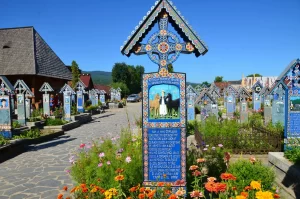
The Merry Cemetery is a unique and colorful burial ground renowned for its vibrant and humorous tombstones that depict the life stories and personalities of the deceased.
Established in the mid-20th century by local artist Stan Ioan Pătraș, the Merry Cemetery stands out as a celebration of life rather than a somber reflection on death.
Each tombstone is adorned with a hand-carved wooden cross painted in bright colors, featuring whimsical illustrations and witty epitaphs that offer a glimpse into the lives, occupations, and quirks of the individuals buried there.
Additionally, visitors to the Merry Cemetery can stroll through the rows of graves, admiring the intricate artwork and reading the clever verses that accompany each tombstone.
In essence, the cemetery’s lighthearted and humorous approach to death provides a unique perspective on mortality and serves as a testament to the resilience and humor of the local community.
In addition to its artistic and cultural significance, the Merry Cemetery offers tourists a glimpse into the traditions and folklore of the Maramureș region.
The vibrant colors, intricate carvings, and heartfelt messages found throughout the cemetery create a truly memorable and uplifting experience for visitors of all ages.
A visit to the Merry Cemetery is not only a chance to pay respects to the departed but also an opportunity to celebrate life, creativity, and the enduring spirit of the human soul.
9. Râșnov Fortress Romania
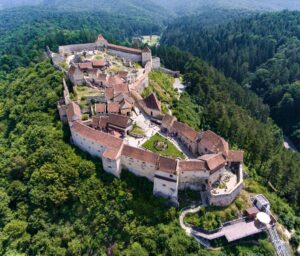
The historic citadel of Râșnov Fortress overlooks the town of Râșnov from a rocky hilltop in Transylvania, Romania.
Built in the 13th century by Teutonic Knights, the fortress served as a strategic stronghold to protect the local population from invasions and attacks.
Visitors to Râșnov Fortress can explore its well-preserved walls, towers, and inner courtyards, offering a glimpse into the medieval past of the region.
The fortress offers panoramic views of the surrounding Carpathian Mountains and the picturesque town of Râșnov below, making it a popular destination for tourists seeking both history and natural beauty.
Within the fortress walls, tourists can visit the museum showcasing artifacts and exhibits related to the history of the fortress and the region.
The fortress also features a charming wooden church, adding to its cultural and architectural significance.
For those interested in outdoor activities, Râșnov Fortress is surrounded by hiking trails and scenic viewpoints, providing opportunities for nature walks and exploration of the surrounding landscape.
Overall, a visit to Râșnov Fortress offers a unique opportunity to step back in time and experience the rich history and stunning scenery of Transylvania.
It is a must-see destination for tourists looking to immerse themselves in the medieval heritage of Romania.
10. Alba Iulia Citadel Romania
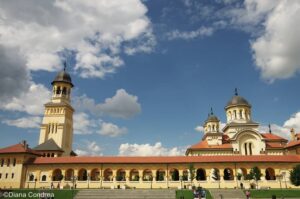
The Alba Iulia Citadel, located in Alba Iulia, Romania, is a historic fortress that, moreover, holds significant cultural and architectural importance.
This well-preserved citadel is a popular tourist destination; moreover, it offers visitors a glimpse into Romania’s rich past and serves as a symbol of national unity.
At the same time, within the citadel walls, tourists can discover a wealth of historical sites, including the stunning Coronation Cathedral, where the first King of Romania was crowned in 1922.
The Citadel’s gates, bastions, and ramparts provide a fascinating insight into the military architecture of the time, while the beautifully landscaped gardens and promenades offer a peaceful retreat for visitors to relax and enjoy the surroundings.
One of the highlights of a visit to the Alba Iulia Citadel is the Changing of the Guard ceremony, a traditional display of military precision and pageantry that takes place daily.
Additionally, the citadel hosts various cultural events, festivals, and exhibitions throughout the year, showcasing the vibrant heritage and traditions of the region.
For tourists seeking to immerse themselves in Romania’s history and culture, a visit to the Alba Iulia Citadel is a must-see experience that promises to leave a lasting impression.







